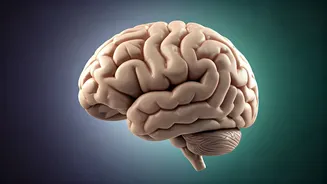Brain on Reels
The human brain is wired to seek rewards, and platforms like Instagram and TikTok have mastered the art of exploiting this. When you scroll through reels,
your brain releases dopamine, a neurotransmitter associated with pleasure and motivation. This creates a cycle where you're driven to keep scrolling to get that next 'hit' of satisfaction. Over time, the brain adapts, requiring more stimulation to achieve the same level of pleasure, similar to how someone builds a tolerance to drugs. The constant exposure to quick bursts of information and entertainment can also lead to attention deficits and difficulty focusing on tasks requiring sustained concentration. This is because the brain becomes accustomed to the rapid pace of reels and struggles to engage with slower-paced content or activities. This can also lead to feelings of restlessness and anxiety when you're not scrolling.
Addiction's Parallel Paths
The mechanisms underlying reel addiction are remarkably similar to those of substance abuse. Both involve the brain's reward system being hijacked. In addiction to substances like alcohol or nicotine, the substance itself triggers dopamine release. With reels, it's the anticipation of the next entertaining video, or the validation from likes and comments that fuels the reward. Both types of addiction can lead to compulsive behaviors. Someone might repeatedly scroll through reels even when it interferes with work, relationships, or other important aspects of their life, just like an alcoholic might prioritize drinking over all else. Withdrawal symptoms, such as irritability, restlessness, and difficulty concentrating, can also emerge when someone tries to cut back on reel usage, mirroring the experience of someone quitting a substance. These parallels highlight the potential seriousness of reel addiction.
Real-Life Consequences
The impact of reel addiction goes beyond the individual's brain; it can also affect everyday life and safety. News reports have highlighted the dangerous behavior of people scrolling through reels while driving. In one case, a passenger was shocked to see an auto driver engrossed in scrolling through reels while behind the wheel. Such actions can lead to accidents and endanger both the driver and others on the road. The problem extends to other settings as well. In another incident, a woman in Bihar panicked when she saw an auto-rickshaw driver scrolling through reels. These real-life instances show that the addiction to reels isn't just a harmless habit; it can have serious and even life-threatening consequences. It underscores the importance of being aware of how our digital habits impact our behaviour and the safety of those around us.
Taking Back Control
Recognizing the potential for reel addiction is the first step toward regaining control. Setting clear boundaries for your social media usage is essential. Consider designating specific times for checking social media and sticking to these limits. Use features like screen time trackers to monitor how much time you spend on these platforms. If you find it difficult to self-regulate, consider using apps or browser extensions that block access to social media during specific periods. It's also helpful to cultivate offline interests and activities. Spending time on hobbies, exercising, or connecting with people face-to-face can help to shift your focus away from reels and reduce your reliance on digital stimulation. Practice mindfulness to become more aware of your triggers and cravings, which is useful in breaking the cycle of addiction.











